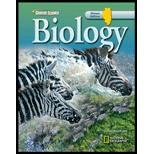
Concept explainers
Introduction:
All cells have a special membrane called plasma membrane that acts as a thin flexible boundary between a cell and its watery environment. It controls what enters and leave the cell. The cells of our skin and that of a plant stem, all have a plasma membrane. It also helps in maintaining homeostasis in an organism. Plasma membranes are selectively permeable as they allow only certain substances to pass through while keeping others out.
Answer to Problem 7STP
Correct answer :
The correct answer is option D. transport proteins in the cell membrane
Explanation of Solution
Explanation/justification for the correct answer:
Option D. transport proteins in the cell membrane- An important property of plasma membrane is selective permeability, by which a membrane allows some substances to pass through while keeping others out. This property is important to the survival of a cell. Proteins that are found on the outer surface of plasma membrane called receptors transmit signals to the inside of the cell. Some proteins span the entire membrane and act as tunnels through which certain substances enter and exit the cell. These transport proteins contribute to the selective permeability of the plasma membrane. They transport the needed substances and waste materials through the membrane. Calcium and sodium ions are also transported in and out of cardiac cells by these transport proteins.
Hence, this is the correct option.
Explanation for incorrect answer:
Option A. charged particles in the phospholipid bilayer- The phospholipids are arranged in such a way, that the polar heads are closest to water molecules. So the fatty acid tails form the interior of the plasma membrane and the heads face the watery environment found inside and outside the cell. This allows the plasma membrane to permit only water and uncharged molecules like oxygen and carbon dioxide.They do not help in transport of calcium and sodium ions in and out of cardiac cells as lipid bilayers are not permeable to charged ions. Hence, this is not the correct option.
Option B. cholesterol molecules in the phospholipid bilayer- Cholesterol molecules are nonpolar and are positioned among the phospholipids in such a way that they prevent the fatty acid tails of the phospholipid bilayer from sticking together. This causes fluidity in the plasma membrane. They do not help in transport of calcium and sodium ions in and out of cardiac cells.Hence, this is not the correct option.
Option C. diffusion channels in the cell membrane- Diffusion channels allow only small ions like chloride ions and sugar to move across plasma membranes. Calcium and sodium ions are not transported in and out of cardiac cells by diffusion. Transport proteins help in movement of charged ions across plasma membranes. Hence, this is not the correct option.
Chapter 10 Solutions
Biology Illinois Edition (Glencoe Science)
Additional Science Textbook Solutions
Applications and Investigations in Earth Science (9th Edition)
Chemistry: The Central Science (14th Edition)
Human Physiology: An Integrated Approach (8th Edition)
Human Anatomy & Physiology (2nd Edition)
Anatomy & Physiology (6th Edition)
Genetic Analysis: An Integrated Approach (3rd Edition)
- Explain how the hormones of the glands listed below travel around the body to target organs and tissues : Pituitary gland Hypothalamus Thyroid Parathyroid Adrenal Pineal Pancreas(islets of langerhans) Gonads (testes and ovaries) Placentaarrow_forwardWhat are the functions of the hormones produced in the glands listed below: Pituitary gland Hypothalamus Thyroid Parathyroid Adrenal Pineal Pancreas(islets of langerhans) Gonads (testes and ovaries) Placentaarrow_forwardDescribe the hormones produced in the glands listed below: Pituitary gland Hypothalamus Thyroid Parathyroid Adrenal Pineal Pancreas(islets of langerhans) Gonads (testes and ovaries) Placentaarrow_forward
- Please help me calculate drug dosage from the following information: Patient weight: 35 pounds, so 15.9 kilograms (got this by dividing 35 pounds by 2.2 kilograms) Drug dose: 0.05mg/kg Drug concentration: 2mg/mLarrow_forwardA 25-year-old woman presents to the emergency department with a 2-day history of fever, chills, severe headache, and confusion. She recently returned from a trip to sub-Saharan Africa, where she did not take malaria prophylaxis. On examination, she is febrile (39.8°C/103.6°F) and hypotensive. Laboratory studies reveal hemoglobin of 8.0 g/dL, platelet count of 50,000/μL, and evidence of hemoglobinuria. A peripheral blood smear shows ring forms and banana-shaped gametocytes. Which of the following Plasmodium species is most likely responsible for her severe symptoms? A. Plasmodium vivax B. Plasmodium ovale C. Plasmodium malariae D. Plasmodium falciparumarrow_forwardStandard Concentration (caffeine) mg/L Absorbance Reading 10 0.322 20 0.697 40 1.535 60 2.520 80 3.100arrow_forward
 Human Anatomy & Physiology (11th Edition)BiologyISBN:9780134580999Author:Elaine N. Marieb, Katja N. HoehnPublisher:PEARSON
Human Anatomy & Physiology (11th Edition)BiologyISBN:9780134580999Author:Elaine N. Marieb, Katja N. HoehnPublisher:PEARSON Biology 2eBiologyISBN:9781947172517Author:Matthew Douglas, Jung Choi, Mary Ann ClarkPublisher:OpenStax
Biology 2eBiologyISBN:9781947172517Author:Matthew Douglas, Jung Choi, Mary Ann ClarkPublisher:OpenStax Anatomy & PhysiologyBiologyISBN:9781259398629Author:McKinley, Michael P., O'loughlin, Valerie Dean, Bidle, Theresa StouterPublisher:Mcgraw Hill Education,
Anatomy & PhysiologyBiologyISBN:9781259398629Author:McKinley, Michael P., O'loughlin, Valerie Dean, Bidle, Theresa StouterPublisher:Mcgraw Hill Education, Molecular Biology of the Cell (Sixth Edition)BiologyISBN:9780815344322Author:Bruce Alberts, Alexander D. Johnson, Julian Lewis, David Morgan, Martin Raff, Keith Roberts, Peter WalterPublisher:W. W. Norton & Company
Molecular Biology of the Cell (Sixth Edition)BiologyISBN:9780815344322Author:Bruce Alberts, Alexander D. Johnson, Julian Lewis, David Morgan, Martin Raff, Keith Roberts, Peter WalterPublisher:W. W. Norton & Company Laboratory Manual For Human Anatomy & PhysiologyBiologyISBN:9781260159363Author:Martin, Terry R., Prentice-craver, CynthiaPublisher:McGraw-Hill Publishing Co.
Laboratory Manual For Human Anatomy & PhysiologyBiologyISBN:9781260159363Author:Martin, Terry R., Prentice-craver, CynthiaPublisher:McGraw-Hill Publishing Co. Inquiry Into Life (16th Edition)BiologyISBN:9781260231700Author:Sylvia S. Mader, Michael WindelspechtPublisher:McGraw Hill Education
Inquiry Into Life (16th Edition)BiologyISBN:9781260231700Author:Sylvia S. Mader, Michael WindelspechtPublisher:McGraw Hill Education





